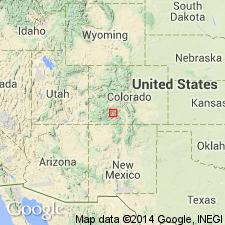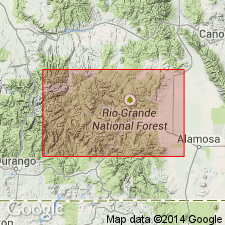
- Usage in publication:
-
- Shallow Creek Quartz Latite*
- Modifications:
-
- Named
- Dominant lithology:
-
- Breccia
- AAPG geologic province:
-
- San Juan Mountains province
Summary:
Named for exposures in drainage basins of Rat Creek, Miners Creek, and Shallow Creek 2 to 4 1/2 mi west of Creede, Mineral Co, CO, San Juan Mountain province. Consists largely of volcanic breccias. Thin lava flows make up less than 10 percent of the formation. Is porphyritic with small phenocrysts set in an aphanitic groundmass. Is irregularly altered, and oxidized and burnt in appearance, or irregularly altered to clay and crisscrossed with quartz and carbonate veinlets. Assigned to the middle Tertiary. Is about the same age as Bachelor Mountain Rhyolite and La Garita Quartz Latite. Formed prior to Farmers Creek Rhyolite and to Huerto Formation.
Source: GNU records (USGS DDS-6; Denver GNULEX).

- Usage in publication:
-
- Shallow Creek unit*
- Modifications:
-
- Revised
- AAPG geologic province:
-
- San Juan Mountains province
Summary:
Revised to informal status and assigned to Carpenter Ridge Tuff. Study is in Creede area, Mineral Co, CO, San Juan Mountain province. Unit now interpreted as landslide and talus breccia derived from northwest wall of Bachelor caldera (in La Garita Mountains) during its subsidence. Breccias are composed of precaldera (Conejos-age) hornblende-bearing dacitic lavas. Table Mountain was one of source stratovolcanoes for dacitic lavas. Bachelor caldera was source of Carpenter Ridge. Previous workers interpreted unit to be a primary volcanic accumulation. Unit had similar origin as breccias of Phoenix Park (revised to informal status) and Outlet Tunnel (reinstated to informal status) units both of Carpenter Ridge. Oligocene age.
Source: GNU records (USGS DDS-6; Denver GNULEX).
For more information, please contact Nancy Stamm, Geologic Names Committee Secretary.
Asterisk (*) indicates published by U.S. Geological Survey authors.
"No current usage" (†) implies that a name has been abandoned or has fallen into disuse. Former usage and, if known, replacement name given in parentheses ( ).
Slash (/) indicates name conflicts with nomenclatural guidelines (CSN, 1933; ACSN, 1961, 1970; NACSN, 1983, 2005, 2021). May be explained within brackets ([ ]).

